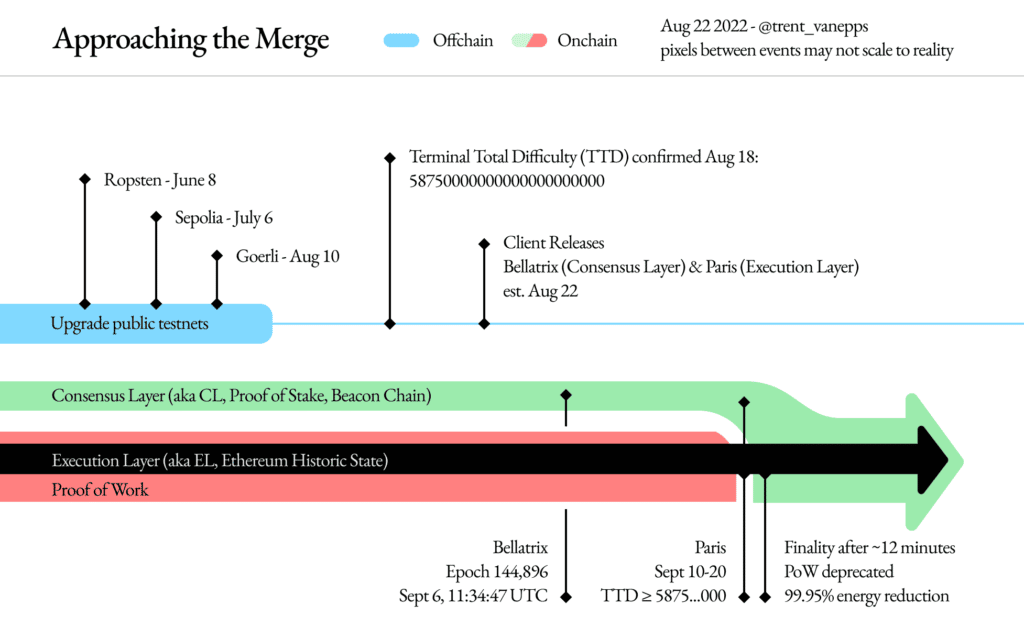As expected, the Bellatrix update of the Ethereum protocol took place yesterday.
Bellatrix is live! We're in the endgame now #TestingTheMerge pic.twitter.com/57qg3A9hdf
— parithosh | 🐼👉👈🐼 (@parithosh_j) September 6, 2022
This is the final update leading to the Merge, which is scheduled to take place between 13 and 15 September.
The merge is still expected to happen around Sep 13-15. What's happening today is the Bellatrix hard fork, which *prepares* the chain for the merge. Still important though – make sure to update your clients!
— vitalik.eth (@VitalikButerin) September 6, 2022
Summary
What is the importance of the Bellatrix update for the Ethereum Merge?
Bellatrix is an extremely important update, because it is the one that concretely marks the transition to PoS, as it introduces key changes to Ethereum’s consensus mechanism.
The official roadmap for the Merge shows how Bellatrix is an update that changes the so-called Consensus Layer, which is that of the new PoS-based Beacon Chain. The one that will perform the actual Merge, however, will be Paris, which will occur simultaneously on both the Consensus Layer and the so-called Execution Layer, which is the old PoW-based blockchain.

The Paris update coincides with the Merge, which is the very execution of the merging of the old PoW-based blockchain into the new PoS-based one.
Therefore, yesterday Bellatrix actually activated the Merge on the new Beacon Chain, while Paris will also activate it on the old blockchain making it for all intents and purposes operational.
The Ethereum Merge, which will replace PoW with PoS, occurs in two phases, and yesterday’s was the first. In this first phase, an update of the Ethereum protocol takes place, requiring an update of the Beacon Chain client software. The second phase, on the other hand, will be triggered automatically when the TTD (Terminal Total Difficulty) level of 58750000000000000000000 is reached.
Reaching this level will initiate the actual Merge, and it will take place between 13 and 15 September.
Once it is reached, the next block on the official Ethereum blockchain will be produced by a Beacon Chain validator, and no longer by the miners.
At this time, the old PoW-based blockchain is still in use, and it is still the miners who are validating the blocks, despite the Bellatrix upgrade. The transition to PoS will occur with the Paris update.

How to prepare for the Ethereum Merge
In order to support the Merge, Ethereum nodes must run both the client operating on the old blockchain and one operating on the new one at the same time. The Bellatrix update involves updating only the latter.
If nodes were not to be updated to the latest version of the client that supports Bellatrix, they would not be able to support the Merge, so it is a step, not only essential, but absolutely necessary.
Interestingly enough, yesterday the price of ETH dropped.
After rising from about $1,550 to $1,670 it suddenly fell to $1,500, but it seems that the Bellatrix upgrade had nothing to do with it. In fact, this descent occurred several hours after the update, and also coincided with a similar drop, in magnitude and speed, of the price of BTC.
The price of Ethereum (ETH)
From its August low of $1,430, touched at the end of the month, it had risen 16% until yesterday’s sudden drop. This rise is probably due precisely to the anticipation of the Merge, also because there is a possibility that thanks to a fork of some miners a new cryptocurrency could be generated that should be distributed for free to all ETH holders.
After the Merge, in theory all ETH miners should stop validating and adding blocks to the old blockchain. However, this is far from certain, because for miners it would mean they would stop cashing in. Many miners have decided to start mining other PoW-based and Ethereum-compatible cryptocurrencies, such as Ethereum Classic (ETC), but some seem intent on wanting to continue mining on the old Ethereum blockchain.
Given that the latest updates to the Ethereum protocol effectively involve the decommissioning of the old PoW-based blockchain, and thus stopping the creation of new Ethereum blocks by mining, a fork is required to continue.
At present the odds of this fork being made and surviving appear to be declining.
The value and speculation on ETHW
A token called ETHW has been created that allows people to bet on the new cryptocurrency that may eventually arise from this fork.
At the beginning of September, the price of ETHW had risen to $55, which is a far lower value than that of ETH, and in recent days it has fallen as much as 30%.
Since an ETHW will be created for every ETH held at the time of the possible fork, should the fork actually occur, direct comparison between the prices of the two tokens is possible.
The current value of ETHW is one-fortieth of ETH, so, for example, someone who will hold $1,000 in ETH at the time of the fork, can receive $25 in ETHW.
The fact is that it is not necessarily convenient for miners to create a new cryptocurrency, and especially a new alternative ecosystem to Ethereum, simply so they can continue mining. In fact, such an ecosystem actually already exists: it is called Ethereum Classic, and its cryptocurrency (ETC) is worth about as much as ETHW.
Ethereum Classic ecosystem, miners shift focus
Since there is already an entire working platform in place that is extremely similar to the one they should create with the PoW fork, and thus requires no effort to create, it is possible that many ETH miners will simply prefer to get down to the business of mining ETC rather than having to put any effort into creating and maintaining a new platform.
It would have been very different, however, if there had been much more consensus around the project of creating a PoW fork of Ethereum, so that something new could actually be created, and not just a bad copy of an existing project.
It is worth noting that the Merge will be there whether the PoW fork happens or not, and that this eventual fork will in no way change either the roadmap or the operation of Ethereum and its transition to PoS. This is just a misguided attempt to defend PoW on Ethereum at a time when Ethereum is abandoning it outright.
The only scenario in which the PoW fork might really make sense is if the Merge is not successful. That is, if there are problems with the introduction of PoS on Ethereum, reverting to PoW might be difficult, and in that case an off-the-shelf PoW version of Ethereum might be successful.
This scenario, however, is commonly considered unlikely to date.
The future of the Ethereum Merge and possible PoW fork
All testing to date has been successful, and given that the Ethereum community has been preparing for this momentous transition for years now, this suggests that it is unlikely that there will be any problems so serious as to force a turnaround.
There is one thing to be careful of, and that is the fact that someone may have purchased ETH these days precisely so that they could hold it at the time of an eventual PoW fork. Thus, if the fork does not happen, they may no longer have any reason to hold ETH, and so they may want to sell them.
This reasoning holds true even if the fork does happen, because ETHW will technically be created and allocated at the time of the fork itself, so once it takes place there is no need to hold ETH to get them, even if the actual distribution were to take place later.
So if the price of ETH in recent weeks were to rise due to the assumption related to the PoW fork, it is possible that sooner or later it could go down, whether if the PoW fork does not take place, or after it takes place.




